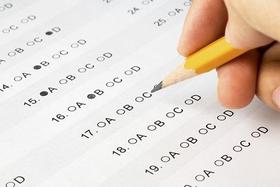Serving 663 students in grades Prekindergarten-5, Spalding Park Elementary School ranks in the bottom 50% of all schools in Iowa for overall test scores (math proficiency is bottom 50%, and reading proficiency is bottom 50%).
The percentage of students achieving proficiency in math is 60% (which is lower than the Iowa state average of 68%). The percentage of students achieving proficiency in reading/language arts is 60% (which is lower than the Iowa state average of 70%).
The student-teacher ratio of 15:1 is higher than the Iowa state level of 14:1.
Minority enrollment is 58% of the student body (majority Hispanic), which is higher than the Iowa state average of 29% (majority Hispanic).
Quick Facts (2025-26)
- Grades: Prekindergarten-5
- Enrollment: 663 students
- Student-Teacher Ratio: 15:1
- Minority Enrollment: 58%
- Overall Testing Rank: Bottom 50% in IA
- Math Proficiency: 60% (Btm 50%)
- Reading Proficiency: 60% (Btm 50%)
- Science Proficiency: 50-54% (Btm 50%)
- Source: National Center for Education Statistics (NCES), IA Dept. of Education
Top Rankings
Spalding Park Elementary School ranks among the top 20% of public schools in Iowa for:
Category
Attribute
Diversity
Percent Eligible For Free Lunch
Student Attention
School Overview
Spalding Park Elementary School's student population of 663 students has stayed relatively flat over five school years.
The teacher population of 45 teachers has stayed relatively flat over five school years.
Grades Offered
Grades Prekindergarten-5
(Supplemental Virtual)
(Supplemental Virtual)
Total Students
663 students
Gender %
Total Classroom Teachers
45 teachers
School Calendar
School Rankings
Spalding Park Elementary School ranks within the bottom 50% of all 1,223 schools in Iowa (based off of combined math and reading proficiency testing data).
The diversity score of Spalding Park Elementary School is 0.71, which is more than the diversity score at state average of 0.47. The school's diversity has stayed relatively flat over five school years.
Overall Testing Rank
#999 out of 1223 schools
(Bottom 50%)
(Bottom 50%)
Math Test Scores (% Proficient)
60%
68%
Reading/Language Arts Test Scores (% Proficient)
60%
70%
Science Test Scores (% Proficient)
50-54%
63%
Student-Teacher Ratio
15:1
14:1
American Indian
2%
n/a
Asian
n/a
3%
Hispanic
31%
13%
Black
12%
7%
White
42%
71%
Hawaiian
6%
1%
Two or more races
7%
5%
All Ethnic Groups
Participates in the National School Lunch Program (NSLP)
Yes
Eligible for Free Lunch
53%
36%
Eligible for Reduced Lunch
16%
5%
School Statewide Testing
School District Name
Source: National Center for Education Statistics (NCES), IA Dept. of Education
Profile last updated: 02/09/2025
Frequently Asked Questions
What is Spalding Park Elementary School's ranking?
Spalding Park Elementary School is ranked #999 out of 1,223 schools, which ranks it among the bottom 50% of public schools in Iowa.
What percent of students have achieved state testing proficiency in math and reading?
60% of students have achieved math proficiency (compared to the 68% IA state average), while 60% of students have achieved reading proficiency (compared to the 70% IA state average).
How many students attend Spalding Park Elementary School?
663 students attend Spalding Park Elementary School.
What is the racial composition of the student body?
42% of Spalding Park Elementary School students are White, 31% of students are Hispanic, 12% of students are Black, 7% of students are Two or more races, 6% of students are Hawaiian, and 2% of students are American Indian.
What is the student-teacher ratio of Spalding Park Elementary School?
Spalding Park Elementary School has a student ration of 15:1, which is higher than the Iowa state average of 14:1.
What grades does Spalding Park Elementary School offer ?
Spalding Park Elementary School offers enrollment in grades Prekindergarten-5 (Supplemental Virtual).
What school district is Spalding Park Elementary School part of?
Spalding Park Elementary School is part of Sioux City Community School District.
School Reviews
Review Spalding Park Elementary School. Reviews should be a few sentences in length. Please include any comments on:
- Quality of academic programs, teachers, and facilities
- Availability of music, art, sports and other extracurricular activities
Recent Articles

How ║┌┴¤═°╣┘═° Schools Support Students on Free / Reduced-Lunch Programs
Explore how U.S. public schools support students eligible for free or reduced-price lunch through nutrition, academic, and wraparound services in 2025.

Hidden Costs of ║┌┴¤═°╣┘═° Schools: Fees, Supplies & Extras
Explore the hidden costs in public schoolsÔÇöfees, supplies, extracurricularsÔÇöand how parents can plan for them in 2025.

║┌┴¤═°╣┘═° School Funding 2025: What Families Should Know
Essential insights on public school funding in 2025ÔÇöhow it works, whatÔÇÖs changing, and what families should know to stay ahead.




